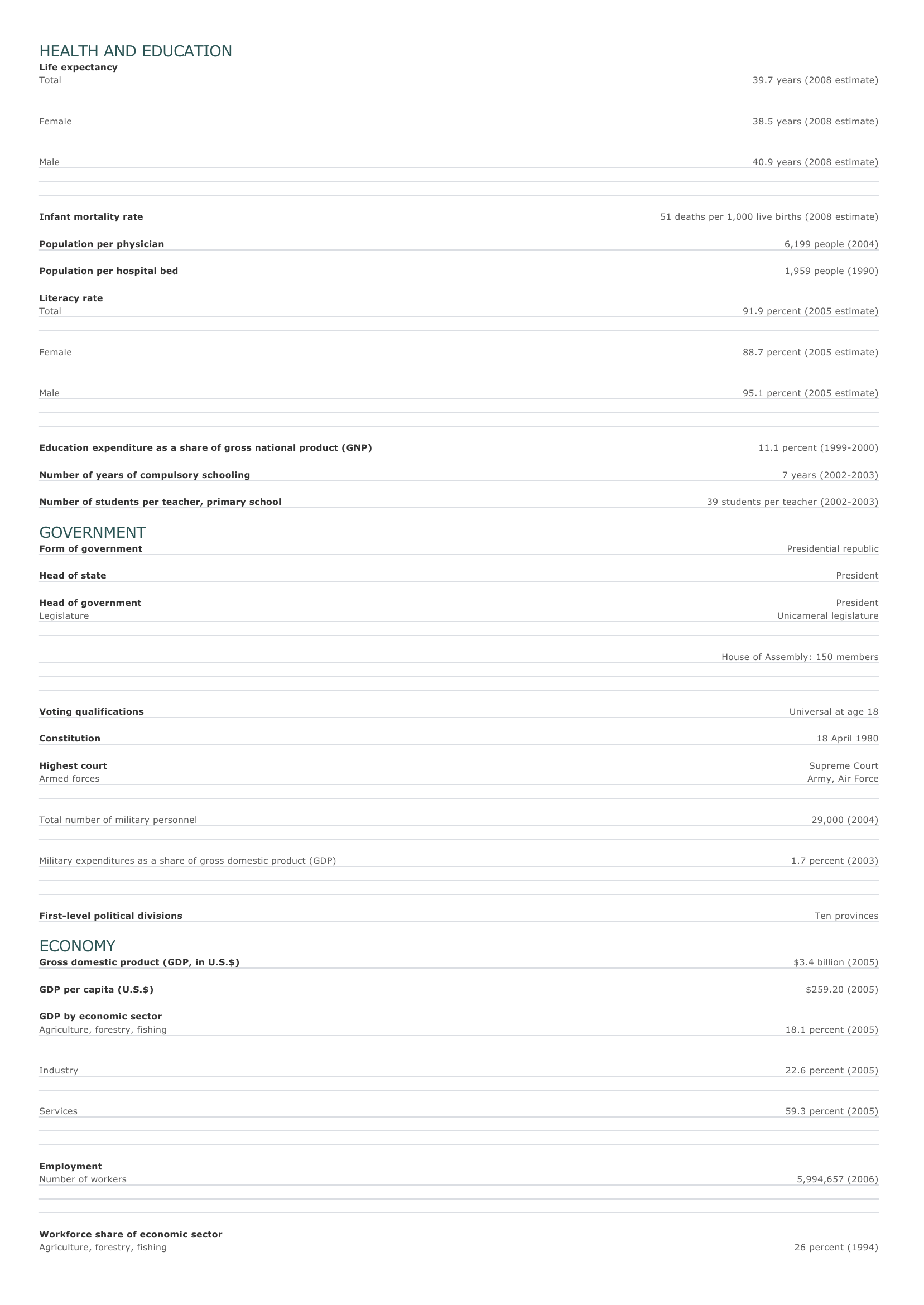
Zimbabwe Facts and Figures. BASIC FACTS Official name Capital Area Republic of Zimbabwe Harare 390,759 sq km 150,873 sq mi PEOPLE Population 12,382,920 (2008 estimate) Population growth Population growth rate 0.57 percent (2008 estimate) Projected population in 2025 12,915,433 (2025 estimate) Projected population in 2050 12,221,257 (2050 estimate) Population density 32 persons per sq km (2008 estimate) 83 persons per sq mi (2008 estimate) Urban/rural distribution Share urban 36 percent (2005 estimate) Share rural 64 percent (2005 estimate) Largest cities, with population Harare 1,469,000 (2003 estimate) B ulawayo 676,787 (2002) Chitungwiza 321,782 (2002) Mutare 153,000 (2002) Gweru 137,000 (2002) Ethnic groups Shona 71 percent Ndebele 16 percent O ther 13 percent Languages English (official), Shona, Ndebele Religious affiliations Syncretic (part Christian, part indigenous beliefs) 40 percent Protestant 12 percent Roman Catholic 10 percent Ethnoreligionists or indigenous beliefs 30 percent Other (including Muslim and Hindu) 8 percent HEALTH AND EDUCATION Life expectancy Total 39.7 years (2008 estimate) Female 38.5 years (2008 estimate) Male 40.9 years (2008 estimate) Infant mortality rate 51 deaths per 1,000 live births (2008 estimate) Population per physician 6,199 people (2004) Population per hospital bed 1,959 people (1990) Literacy rate Total 91.9 percent (2005 estimate) Female 88.7 percent (2005 estimate) Male 95.1 percent (2005 estimate) Education expenditure as a share of gross national product (GNP) Number of years of compulsory schooling Number of students per teacher, primary school 11.1 percent (1999-2000) 7 years (2002-2003) 39 students per teacher (2002-2003) GOVERNMENT Form of government Head of state Head of government Legislature Presidential republic President President Unicameral legislature House of Assembly: 150 members Voting qualifications Constitution Universal at age 18 18 April 1980 Highest court Supreme Court Armed forces Army, Air Force Total number of military personnel Military expenditures as a share of gross domestic product (GDP) First-level political divisions 29,000 (2004) 1.7 percent (2003) Ten provinces ECONOMY Gross domestic product (GDP, in U.S.$) GDP per capita (U.S.$) $3.4 billion (2005) $259.20 (2005) GDP by economic sector Agriculture, forestry, fishing 18.1 percent (2005) I ndustry 22.6 percent (2005) Services 59.3 percent (2005) Employment Number of workers 5,994,657 (2006) Workforce share of economic sector Agriculture, forestry, fishing 26 percent (1994) I ndustry 28 percent (1994) Services 47 percent (1994) Unemployment rate 8.2 percent (2002) National budget (U.S.$) Total revenue $2,834,017 million (1997) Total expenditure $2,483,947 million (1997) Monetary unit 1 Zimbabwe dollar (Z$), consisting of 100 cents Agriculture Tobacco, cotton, maize, sugarcane, coffee, cassava, wheat, sorghum, millet, cattle Mining Chromium, gold, nickel, asbestos, copper, silver, emeralds, lithium, tin, iron ore, cobalt, coal, diamonds, kyanite, platinum, zinc, lead Manufacturing Food products, metals, chemicals, textiles Major exports Tobacco, ferrochrome, gold, nickel metal, cotton, steel, textiles Major imports Machinery and transportation equipment, basic manufactures, chemicals, fuels Major trade partners for exports United Kingdom, Germany, South Africa, Japan, and China Major trade partners for imports South Africa, Congo (DRC), Mozambique, United Kingdom, and Germany ENERGY, COMMUNICATIONS, AND TRANSPORTATION Electricity production Electricity from thermal sources 50.83 percent (2003 estimate) Electricity from hydroelectric sources 49.17 percent (2003 estimate) Electricity from nuclear sources 0 percent (2003 estimate) Electricity from geothermal, solar, and wind sources 0 percent (2003 estimate) Number of radios per 1,000 people 402 (1999 estimate) Number of telephones per 1,000 people 25 (2005) Number of televisions per 1,000 people 36 (2000 estimate) Number of Internet hosts per 10,000 people 3.8 (2003) Daily newspaper circulation per 1,000 people 18 (1996) Number of motor vehicles per 1,000 people 50 (2002) Paved road as a share of total roads 19 percent (2002) SOURCES Basic Facts and People sections Area data are from the statistical bureaus of individual countries. Population, population growth rate, and population projections are from the United States Census Bureau, International Programs Center, International Data Base (IDB) (www.census.gov). Urban and rural population data are from the Food and Agriculture Organization (FAO) of the United Nations (UN), FAOSTAT database (www.fao.org). Largest cities population data and political divisions data are from the statistical bureaus of individual countries. Ethnic divisions and religion data are largely from the latest Central Intelligence Agency (CIA) World Factbook and from various country censuses and reports. Language data are largely from the Ethnologue, Languages of the World, Summer Institute of Linguistics International (www.sil.org). Health and Education section Life expectancy and infant mortality data are from the United States Census Bureau, International Programs Center, International database (IDB) (www.census.gov). Population per physician and population per hospital bed data are from the World Health Organization (WHO) (www.who.int). Education data are from the United Nations Educational, Scientific and Cultural Organization (UNESCO) database (www.unesco.org). Government section Government, independence, legislature, constitution, highest court, and voting qualifications data are largely from various government Web sites, the latest Europa World Yearbook, and the latest Central Intelligence Agency (CIA) World Factbook. The armed forces data is from Military Balance. Economy section Gross domestic product (GDP), GDP per capita, GDP by economic sectors, employment, and national budget data are from the World Bank database (www.worldbank.org). Monetary unit, agriculture, mining, manufacturing, exports, imports, and major trade partner information is from the statistical bureaus of individual countries, latest Europa World Yearbook, and various United Nations and International Monetary Fund (IMF) publications. Energy, Communication, and Transportation section Electricity information is from the Energy Information Administration (EIA) database (www.eia.doe.gov). Radio, telephone, television, and newspaper information is from the United Nations Educational, Scientific and Cultural Organization (UNESCO) database (www.unesco.org). Internet hosts, motor vehicles, and road data are from the World Bank database (www.worldbank.org). Note Figures may not total 100 percent due to rounding. Microsoft ® Encarta ® 2009. © 1993-2008 Microsoft Corporation. All rights reserved.













